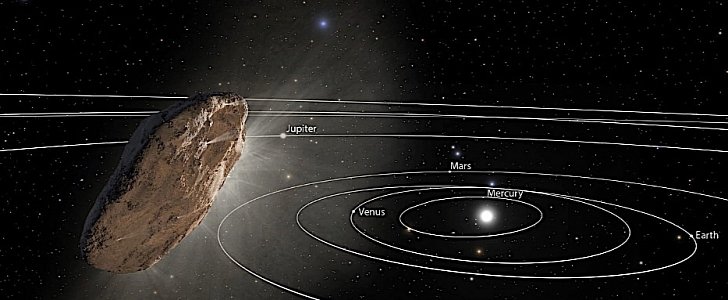It’s not much we can do, with our limited technology, to properly indentify an object in space as a spaceship or just a lifeless rock. But we can rely on two precise measurements, that may hint at the possibility of alien intelligence behind such an object: acceleration / deceleration and course corrections.
When it was first spotted on 19 October 2017, Oumuamua's strange shape and behavior raised hopes in many that it was a spaceship from another world. It took scientist about a week to state that yes, the object is indeed special, but no, it is not a spaceship.
Oumuamua is the first known interstellar object to enter our solar system. That means it comes from outside our known neighborhood, appearing to have arrived here from the direction of the star Vega in the constellation Lyra. No one can really tell from where it originated.
The object is estimated to be about 230 by 35 meters in size (800 feet × 100 feet) and was classified at first as a comet, then as an asteroid. As of this week, Oumuamua is officially an active comet.
That’s because NASA, using observations from Hubble Space Telescope and ground-based observatories, reached the conclusion that the object accelerated and changed its course as it passed through the inner solar system last year.
"Our high-precision measurements of 'Oumuamua's position revealed that there was something affecting its motion other than the gravitational forces of the Sun and planets," said Marco Micheli from the European Space Agency.
The cause, scientists say, are jets of gaseous material expelled from the object’s surface, the same as the “kind of outgassing [that] affects the motion of many comets in our solar system."
For the record, none of the observations made were able to detect outgassing from Oumuamua, as confirmed by team scientist Olivier Hainaut of the European Southern Observatory. The official goes on to add that the dust particles produced might not enough to be detected, but enough to give the object a jolt.
Work on finding more about Oumuamua will continue before it leaves our solar system for good four years from now.
Our hope that this outgassing theory is wrong are we are in fact dealing with an alien Elon Musk out for a sightseeing trip through the universe.
In the meanwhile, you can read the NASA statement on Oumuamua's acceleration and course change in the document attached below.
Oumuamua is the first known interstellar object to enter our solar system. That means it comes from outside our known neighborhood, appearing to have arrived here from the direction of the star Vega in the constellation Lyra. No one can really tell from where it originated.
The object is estimated to be about 230 by 35 meters in size (800 feet × 100 feet) and was classified at first as a comet, then as an asteroid. As of this week, Oumuamua is officially an active comet.
That’s because NASA, using observations from Hubble Space Telescope and ground-based observatories, reached the conclusion that the object accelerated and changed its course as it passed through the inner solar system last year.
"Our high-precision measurements of 'Oumuamua's position revealed that there was something affecting its motion other than the gravitational forces of the Sun and planets," said Marco Micheli from the European Space Agency.
The cause, scientists say, are jets of gaseous material expelled from the object’s surface, the same as the “kind of outgassing [that] affects the motion of many comets in our solar system."
For the record, none of the observations made were able to detect outgassing from Oumuamua, as confirmed by team scientist Olivier Hainaut of the European Southern Observatory. The official goes on to add that the dust particles produced might not enough to be detected, but enough to give the object a jolt.
Work on finding more about Oumuamua will continue before it leaves our solar system for good four years from now.
Our hope that this outgassing theory is wrong are we are in fact dealing with an alien Elon Musk out for a sightseeing trip through the universe.
In the meanwhile, you can read the NASA statement on Oumuamua's acceleration and course change in the document attached below.



